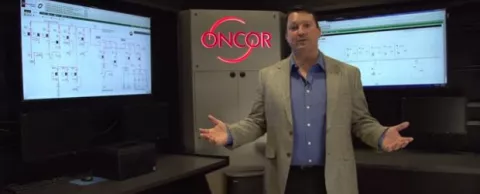
Two recent announcements give us important hints about the future of microgrids. A microgrid encompasses a proscribed area such as a campus, district or military base. It includes some generation on-site or nearby and typically some energy storage as well. If the main grid fails, the microgrid can isolate itself and serve the area's most critical loads (such as hospitals and shelters).
A single microgrid is complicated enough, but the real challenge has been federating multiple microgrids. Thanks to Schneider Electric, S&C Electric and Oncor (a Texas-based electric power utility), that challenge has now been overcome, as explained in the announcement and video below. The new system includes four interconnected microgrids tapping into nine different generation sources.
These and other advances seem poised to unleash the market. After years of pilots and demos and tests, the microgrid sector is finally beginning to accelerate. As you'll read, Navigant Research predicts that so-called "community resilience microgrids" will grow from today's minuscule $163 million to $1.4 billion annually by 2024.
Conclusions:
1) Cities should cautiously explore microgrids to protect their most critical facilities. They should also encourage the private sector to do the same (hospitals, for instance).
2) Cities should focus on the resiliency aspect. Although microgrids have other benefits and uses, resiliency is usually the only thing that justifies the cost.
3) Cities should talk to their utility first. Not every utility is as progressive as Oncor, so some cities may have to go it alone. But it can't hurt to ask.
4) When talking to utilities in some parts of the world, cities should also find out what policy changes are necessary to allow utilities to get a fair return to build and operate microgrids. Many jurisdictions are hampered by archaic regulations.
Council Lead Partners S&C Electric Company and Schneider Electric unveiled one of the most advanced microgrids in North America for Oncor, an electric transmission and distribution company serving 10 million customers across Texas. The microgrid is engineered to maximize newly installed energy storage, renewable generation and improve reliability.
S&C teamed with Schneider to combine new hardware and software technologies for the state-of-the-art facility near Lancaster, Texas, which includes an integrated demonstration center for Oncor to showcase the microgrid’s advanced capabilities and customer benefits.
Showing how utilities can help their communities
LEARN MORE
Contact S&C Electric to arrange a tour of Oncor's microgrid. Email S&C
Learn more about microgrids. Visit Schneider Electric's website
Learn more about Oncor. Visit Oncor's website
"Improving power reliability and optimizing generation assets requires disruptive technologies that allow customers to work on and off the grid," says David Chiesa, director, Microgrid Business Development at S&C. "Oncor’s microgrid is showing the world how utilities can help their communities in the future."
During a loss-of-power event, a combination of S&C’s advanced distribution automation equipment and Schneider’s Microgrid Controller use high-speed communications and distributed grid intelligence to automatically detect a problem on the grid.
"Working with Oncor and S&C to demonstrate how demand side operation cost effectively brings grid scale dispatch and optimization technology to the microgrid is exciting," says Philip Barton, Microgrid Program Director of Schneider. "I am confident that Oncor’s system is one of the most advanced and comprehensive microgrids in the market today."
###
Jesse Berst is the founding Chairman of the Smart Cities Council. Click to learn about the benefits you receive when you join the Council for free. Follow @Jesse_Berst and connect on LinkedIn.



